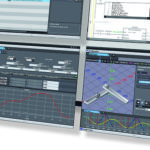For those looking to bring manufacturing intelligence to legacy production sites, B&R Automation introduced its new Orange Box at the 2017 Hannover Fair. According to company officials, the Orange Box lets machine operators collect and analyze data from previously isolated machines and production lines and upgrade them for IIoT/Industry 4.0 operations—with a minimal effort.

An Orange Box consists of a controller and preconfigured software blocks called mapps. The controller collects operating data from any machine via its I/O channels or a fieldbus connection—regardless of who supplied the existing control system. From this data, the mapps generate and display overall equipment effectiveness (OEE) ratings and other KPIs, and can also share the information with higher-level systems via OPC-UA.
Installing the modular Orange Box requires no changes to existing hardware or software, said company officials. Users only need a 25-mm-wide compact PLC and the mapp OEE component to collect and analyze basic operating data. For more advanced features, such as alarm management or energy monitoring, the system can be scaled up with more powerful PLCs and add-on software.
Besides PLC capabilities, a Power Panel or a Panel PC can give the Orange Box an up-to-date user interface. Equipment owners can reportedly see a substantial productivity boost with a relatively small investment in time and cost.
The Orange Box is suitable for transforming brownfield plants into smart factories, said Ralf Hagen, E&A engineering manager at Nestlé Germany. In a smart factory, components need a better way to communicate and interact than in traditional setups, he explained. “There should be an unbroken logical chain for each customer order that can be executed automatically, start to finish. A machine should know when it needs to speed up or slow down—when it should request additional materials or refuse them. Currently, these decisions still require the experience of human operators, but in the future the machines should be able to handle them autonomously,” he said.
“One characteristic of a smart factory is certainly resource efficiency, with reduced consumption and the resulting reduction in operating costs,” added Thomas Rienessl, head of industry-specific business development at B&R. “Virtually all modern equipment is automated by intelligent components that produce enormous amounts of data. Manufacturers are therefore looking for ways to leverage this data to be more competitive. That can mean making production processes more agile and responsive, for example, or increasing availability by preventing unplanned downtime.”
And the reality at Nestlé, explained Hagen, is that the level of intelligence at various plants varies widely around the world.
“Smaller plants have less clout when it comes to innovations, market penetration and investments. Our plants vary greatly with regard to sector and size, so the level of smart manufacturing really runs the gamut,” he added.
Nonetheless, Nestlé has set OEE targets and time frames for achieving them, and there are numerous other related issues, said Hagen.
“If your machine has problems with unplanned downtime, for example, you also tend to have problems with operator safety. The more often they have to intervene, the greater the risk of injury. Another key aspect is energy efficiency. When a line is constantly starting and stopping and starting and stopping, that has a real impact on consumption. At the same time quality suffers, because of the waste that is produced when the machine is starting up or shutting down.”
“The challenge is always to figure out how to improve production with the means and equipment you actually have on hand,” said Rienessl. “In practice, greenfield plants are simply far outnumbered by brownfield ones. The real challenge in terms of productivity is therefore to get more out of the assets that are already in place.”
That’s why Nestlé turned to B&R and the Orange Box to upgrade its plant in Osthofen, Germany, he continued. The product is a versatile, open system for collecting, standardizing and evaluating data in real time, and it readily adapts if requirements change. “The Orange Box allows machine operators to check relevant parameters on site and intervene immediately when necessary. When you’re talking about high availability, it’s essential that any deviations are detected early and the right corrective measures are taken right away. That’s exactly what the Orange Box lets you do, which is why it has been so well received.
“The Orange Box can be used in any industry, but it’s particularly well suited for plants where there are large numbers of machines involved in the production process. Basically there are two types of customers that it appeals to: large industrial manufacturers and machine builders,” said Rienessl.
“Installing and configuring the prototype turned out to be even faster and easier than we expected,” noted Hagen. “Now we’re working on improving the analysis results and how they are displayed for daily use such as shift handover meetings. What we want to have is intelligent analysis that identifies the root causes of a problem before the problem ever occurs. Over the next four years, we want to get to a place where the machines warn us of an impending stoppage in advance, rather than having to troubleshoot after the fact the way we do now. Eventually, there should be no more unplanned downtime whatsoever, and the Orange Box will help us increase both machine availability and output.”
B&R Automation • www.br-automation.com







Leave a Reply
You must be logged in to post a comment.